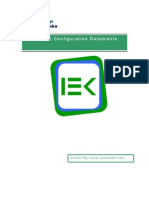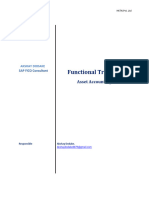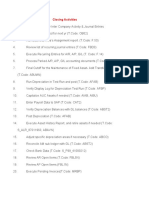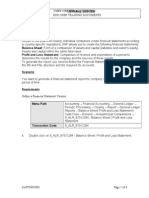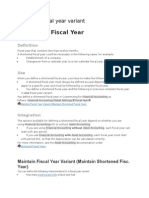Fixed Asset Process Guide
Fixed Asset Process Guide
Uploaded by
kumar4868Copyright:
Available Formats
Fixed Asset Process Guide
Fixed Asset Process Guide
Uploaded by
kumar4868Copyright
Available Formats
Share this document
Did you find this document useful?
Is this content inappropriate?
Copyright:
Available Formats
Fixed Asset Process Guide
Fixed Asset Process Guide
Uploaded by
kumar4868Copyright:
Available Formats
Fixed Assets Process Guide
Control over Assets
Fixed Assets Process Guide
Control over Assets
SAP (& SUN)
This Guide represents current processes about how the Fixed Asset Process will be operated. This guide has been produced in consultation with FABS, Internal Audit and staff.
The United Kingdoms international organisation for educational opportunities and cultural relations. We are registered in England as a charity.
Fixed Assets Process Guide
Control over Assets
Contents
Introduction ....................................................................................................................................... 3 Scope................................................................................................................................................ 3 Process Overview ............................................................................................................................. 3 Business Process Ownership ........................................................................................................... 4 Definition of Roles in the Fixed Asset Process ................................................................................. 4 Responsibilities within the Process................................................................................................... 4 Process List, Descriptions & Process Flows ..................................................................................... 5 For staff in offices on SAP ................................................................................................................ 5 For staff on offices on SUN............................................................................................................... 7 For Financial Accounts Staff (in London).......................................................................................... 9 Supporting Documentation & Management Trail ............................................................................ 10
Correct as at 12th February 2009. Printed copies should not be relied upon. Page 2 of 10
Fixed Assets Process Guide
Control over Assets Introduction
1. This document sets out the procedural instructions necessary to implement the standard SAP/FABS
process for Fixed Assets processing globally in the British Council. 2. The document should be read in conjunction with the other SAP Process Guides, Finance Fixed Assets policy, and SAP Easy Step Guides. 3. For policy on what constitutes a fixed asset refer to the Fixed Asset Policy on the Finance Intranet. 4. Also refer to the Fixed Asset Master Maintenance and Data Standards Policy.
Scope
5. This document cover all the processes required to carry out the SAP Fixed Asset process. 6. This document covers those processes to be carried out in the UK and in overseas countries running SAP. 7. The process to be followed overseas where countries are running SUN accounts
Process Overview
8. The person responsible for controlling and monitoring the Fixed Asset module and all associated tasks is the Financial Accountant. 9. All asset purchases will fall into one of the seven categories of fixed asset: Category Furniture and Equipment IT Equipment Plant and Machinery Vehicles Land and Buildings Building Improvements Permanent Art Collection SAP GL Profit & Loss account 689010 689011 689012 689030 689040 689050 689061 SUN Account Codes 2810 2811 2812 2830 2840 2850 2861
10. To record details of asset purchase/creation, asset disposal and occasionally asset transfer (from one office/country to another) specifically designed forms have been devised and must be used, these are known as the FIN series forms. 11. New Asset purchases should be recorded on the FIN 30. Disposals on the FIN 32 and transfers on the FIN 31 form. 12. These forms will be sent to Financial Accounts in London for recording onto the fixed asset module of SAP 13. The Capitalisation date of an asset is when it first comes into use. This is normally the date the purchased item is received/ goods receipted/ the date first used. 14. Depreciation of an asset starts in the next quarter after the assets capitalisation i.e. capitalised between st th st 1 April and 30 June then depreciation starts from 1 July 15. Depreciation will be run monthly, centrally by Financial Accounts for all company codes. Depreciation will be charged directly to the internal order or WBS of the region or dept.
Correct as at 12th February 2009. Printed copies should not be relied upon. Page 3 of 10
Fixed Assets Process Guide
Control over Assets
16. Revaluation is run by Financial Accounts each year for all assets categories except land and buildings. Land and buildings are revalued to the market valuation every 5 years. Financial Accounts and Global Estates co-ordinates this process.
Business Process Ownership
17. The Business Process Owner (BPO) is the strategic owner of the business process and is responsible for the business effectiveness and efficiency of the process. All BPOs are senior managers in the business area. 18. The Business Process Owner (BPO) for Fixed Assets is the Financial Controller.
Definition of Roles in the Fixed Asset Process
19. The roles referred to within the Fixed Asset process are as follows:
Financial Accountant Assistant Financial Accountant Financial Accounting Officer Operational Staff
Responsibilities within the Process
20. Financial Accountant. Responsible for: Managing and controlling the overall process of Fixed Assets
21. Financial Accounting Officer. Responsible for: Reconciling the Fixed Asset Module to GL Running the monthly SAP depreciation process - see below Entering the FIN 30/ 31/ 32 information into the SAP Fixed Asset Module All adjustments and corrections to the Asset Register The running of various fixed asset reports Publish Fixed Assets Register (FAR) on quarterly basis on the Finance Intranet.
22. Operational Staff. Responsible for: Ensuring that a correct and authorised budget exists for all purchases and all appropriate procurement procedures have been carried out Raising of the appropriate FIN30 series form to record new asset purchases, disposals or transfers Sending FIN30 series forms to Financial Accounts in London Staff may request a copy of their department/office/country fixed asset register at anytime from Financial Accounts Ensure that the expenditure is charged to the appropriate Fixed Asset G/L account as indicated in the table of this document under section 9 & also ensure that the FIN 30 amount matches the expenditure charged to the G/L account.
Correct as at 12th February 2009. Printed copies should not be relied upon. Page 4 of 10
Fixed Assets Process Guide
Control over Assets Process List, Descriptions & Process Flows
23. The following Fixed Asset Tasks are covered in this guide. Process Description Creating Fixed Assets Disposal of Fixed Assets Depreciation of Fixed Assets Transfer of Fixed Assets Revaluation of Fixed Assets Process Flow Ref. FA/1 FA/2 FA/3 FA/4 FA/5 Annex Page 11 Page 12 Page 13 Page 14 Page 15
For staff in offices on SAP
24. Creating Fixed Assets (FA/1) Refer to Essential Finance for guidance before purchasing new assets Assets will be purchased through standard SAP Purchase to Pay by creation of a Purchase Order Before proceeding with purchase you must ensure you have an agreed and authorised budget Fixed assets must be charged to the appropriate GL accounts in the range 689010 689061 on an appropriate WBS in SAP. The threshold to capitalise an asset is 3000 and over, any amount under this will not be classed as a fixed asset. Once the Purchase Order has been approved and the Goods Receipt completed a new asset must be added to the SAP Fixed Asset Register, by completing a FIN 30 form Complete the FIN 30 form (available on the Finance intranet site, under Forms, templates and manuals). The date first used (normally the same date as goods receipt) is critical as this will be used as the capitalisation date of the asset from which all subsequent depreciation will be calculated Send the FIN 30 to Financial Accounts in London. [It is intended that after a period of stabilisation overseas countries will pass details of new assets to their local Accounting Services to create on SAP for their company code] Financial Accounts will check the form and resolve any queries with the office/ department Financial Accounts check that the purchase has been charged to the appropriate 689 series GL codes. Financial Accounts add the new asset details into SAP. The asset is created and journal entries generated to debit the appropriate balance sheet asset category account and credit account 689110 (Furniture & Equipment), 689011 (IT equipment), 689112 (Plant & Machinery), 689130 (vehicles), 689140 (Land & Building), and 689151 (building improvements) which shows on the originating WBS. It should be noted that to report on fixed asset expenditure it will be necessary to exclude the 689110 (Furniture & Equipment), 689111 (IT equipment), 689112 (Plant & Machinery), 689130 (vehicles), 689140 (Land & Building), and 689151 (building improvements) accounts, since its inclusion would net the expenditure to zero. (these GL codes are used for capitalisation only)
Correct as at 12th February 2009. Printed copies should not be relied upon. Page 5 of 10
Fixed Assets Process Guide
Control over Assets
Note: If a department/ office/ country, operating SAP purchases a fixed asset on behalf of another office/ country, who are on SUN they raise a standard PO, in the normal way ensuring the appropriate fixed asset GL code is used but they need to use Account Assignment code F for Internal Order. The originating office should give their SUN Budget Centre which is used as the internal order on the PO. (If the budget centre is KENGART this is switched around to GARTKEN for the internal order.) See Authority to charge a non-SAP location for payment made from SAP (P2P/12 annex 21) previously cross charging, section in the SAP Purchase to Pay Process Guide for full details.
25. Disposal of Fixed Assets FA/2 Refer to Essential Finance for guidance before disposal of an asset. An asset should be disposed of when scrapped, lost, stolen or sold. An asset must remain on the fixed asset register until such time as they are physically scrapped or thrown away. Although assets are depreciated over time, until eventually they are fully depreciated and no longer have an accounting value, they should not be removed from the register for this reason. If an asset is sold ensure payment is banked and the revenue should be charged to GL account 450050 and WBS element Complete a FIN 32 form (available on the Finance intranet site, under Forms, templates and manuals). Send the FIN 32 to Financial Accounts in London. [It is intended that after a period of stabilisation overseas countries will pass details of asset disposal to their local Accounting Services to record on SAP for their company code] Ensure you have quoted the asset number; this should be the new asset no. that has been generated on SAP. Check local copy of Fixed Asset Report for the asset number. A new copy of asset register report can be requested from Financial Accounts, as required Financial Accounts will check the form and resolve any queries with the office/ department Financial Accounts will process the disposal through SAP. Any loss will be automatically calculated and posted to GL account 680100 on the originating WBS. If an asset is lost or stolen the country needs to complete a loss report authorised by the Director and send it to Financial Controller for action If the asset was sold the value of the asset sale is entered and any loss or gain is automatically calculated and posted to GL account 450060 (gain) or 680100 (loss) on the originating WBS.
26. Depreciation of Fixed Assets FA/3 Depreciation will be run centrally by Financial Accounts Depreciation is run monthly as part of End of Month processes The SAP fixed asset module will calculate the depreciation charge for assets based on internal rules Depreciation is the decrease in value of an item over time Accounting entries are generated to post the depreciation charges, these debit 680000 on the originating WBS and credit the appropriate balance sheet fixed asset category Offices must ensure sufficient money has been allocated to WBS to cover the full cost of depreciation for the entire year.
Correct as at 12th February 2009. Printed copies should not be relied upon. Page 6 of 10
Fixed Assets Process Guide
Control over Assets
IMPORTANT: All Countries going live (changing from Sun to SAP) must provide Financial Accounts with WBS structures that will replace the internal orders used to record fixed asset transactions. 27. Transfer of Fixed Assets FA/4 Refer to Essential Finance for guidance before transferring an asset. The country/ office/ or department transferring an asset (the sending office) completes the first part of the FIN 31 form. Ensure the asset number is entered. Check local copy of Fixed Asset Report for the asset number. (A new copy of asset register report can be requested from Financial Accounts, as required.) The form to be signed by an authorised officer. Keep a copy for local records. Send the FIN 31 to the country/ office/ department receiving the asset. The receiving office completes the second part of the FIN 31. Resolve any problems with the sending office. A SAP WBS element is needed for any depreciation charge. FIN 31 form to be signed by an authorised officer. Keep a copy for local records. Send the FIN 31 to Financial Accounts in London. [It is intended that after a period of stabilisation overseas countries will pass details of transfers to their local Accounting Services to record on SAP for their company code] Financial Accounts will check the form and resolve any queries with the office/ departments involved Financial Accounts will process the transfer through SAP.
Any depreciation charges will now be borne by the new owner of the asset. 28. Revaluation of Fixed Assets FA/5 Revaluation of Fixed Assets is completed by Financial Accounts in Spring Gardens. All fixed assets in terms of land, buildings and building improvements are re-valued (based upon the difference between purchase price and market value) once in each 5 years. The British Council tenders a chartered service to value all properties worldwide. The valuation difference is used to calculate the revaluation of all land & buildings. Other fixed assets (e.g. Vehicles, IT Equipments) are re-valued each year based upon existing market valuation. Inflation index numbers issued by UK Treasury / National Statistics are used for the same. Annually FA sources the price indices from national Statistics and populates the index table in SAP using transaction OAV5. The revaluation is then generate in the system using transaction AFAR this creates a debit to the particular asset revaluation series G/L and credits 299050 current cost accounting reserve
For staff on offices on SUN
29. Creating Fixed Assets (FA/1) Refer to Essential Finance for guidance before purchasing new assets Assets will be purchased through standard and existing procurement process in offices, running SUN Accounts
Correct as at 12th February 2009. Printed copies should not be relied upon. Page 7 of 10
Fixed Assets Process Guide
Control over Assets
Before proceeding with purchase you must ensure you have an agreed and authorised budget Fixed assets must be charged to the appropriate GL accounts. SUN countries continue to charge to the old 2800 series accounts, these will be converted by the SUN SAP interface to the appropriate SAP 689000 series accounts. The Budget Centre code will be converted to a SAP Internal Order. Once the Asset has been purchased, A new asset must be added to the SAP Fixed Asset Register, via completing a FIN 30 form Complete the FIN 30 form (available on the Finance intranet site, under Forms, templates and manuals). The date first used (normally the date the asset is acquired) is critical as this will be used as the capitalisation date of the asset from which all subsequent depreciation will be calculated Send the FIN 30 to Financial Accounts in London. Financial Accounts will check the form and resolve any queries with the office/ department Financial Accounts check that the purchase has been charged to the appropriate SAP 689000 series accounts. For SUN countries there may be a timing issue relating to when the local office transactions get uploaded into SAP. At month-end SUN export files are received from countries and by Geographical Accounting Services Financial Accounts add the new asset details into SAP. The asset is created and journal entries generated to debit the appropriate balance sheet asset category account and credit the appropriate G/L account 689XXX account (the asset clearing/control account) Note: If a department/ office/ country, operating SUN is required to purchase a fixed asset on behalf of another office/ country, who are on SAP, then the UK department or country on SAP, must raise a SUN Interface PO first and email the details to the purchasing office. See Authority to charge a SAP budget for payment made by a non-SAP location - previously cross charging, section in the SAP Purchase to Pay Process Guide for full details.
30. Disposal of Fixed Assets FA/2 Refer to Essential Finance for guidance before disposal of an asset. An asset should be disposed of when scrapped, lost, stolen or sold. An asset must remain on the fixed asset register until such time as they are physically scrapped or thrown away. Although assets are depreciated over time, until eventually they are fully depreciated and no longer have an accounting value, they should not be removed from the register for this reason. If an asset is sold ensure payment is banked and the revenue should be charged to GL account 3800 on an appropriate Budget Centre Complete a FIN 32 form (available on the Finance intranet site, under Forms, templates and manuals). Send the FIN 32 to Financial Accounts in London. Ensure you have quoted the asset number. (Same as above) Check local copy of Fixed Asset Report for the asset number. (A new copy of asset register report can be requested from Financial Accounts, as required.) Financial Accounts will check the form and resolve any queries with the office/ department Financial Accounts will process the disposal through SAP. Any loss will be automatically calculated and posted to GL account 2898. If an asset is lost or stolen the country needs to complete a loss report authorised by the Director and send it to Financial Controller for action
Correct as at 12th February 2009. Printed copies should not be relied upon. Page 8 of 10
Fixed Assets Process Guide
Control over Assets
If the asset was sold, the value of the asset sale is entered and any loss or gain is automatically calculated and posted to the SAP equivalent of GL account 3898 (gain) or 2898 (loss) on the originating SAP Internal Order. The charge will be passed back to the country converting the SAP Internal Order to the original Budget Centre, via the interface on the Zinte file.
31. Depreciation of Fixed Assets FA/3 Depreciation will be run centrally by Financial Accounts Depreciation is run monthly as part of End of Month processes The SAP fixed asset module will calculate the depreciation charge for assets based on internal rules Depreciation is the decrease in value of an item over time Accounting entries are generated by Financial Accounts to post the depreciation charges, debiting 2899 OMOC for each asset depreciated and crediting the appropriate balance sheet fixed asset category. The depreciation debit will be passed back to SUN countries through the Zinte file produced by Geographical Accounting Services.
32. Transfer of Fixed Assets FA/4 Refer to Essential Finance for guidance before transferring an asset. The country/ office/ or department transferring an asset (the sending office) completes the first part of the FIN 31 form. Ensure the asset number is entered. Form to be signed by an authorised officer. Keep a copy for local records. Send the FIN 31 to the country/ office/ department receiving the asset. The receiving office completes the second part of the FIN 31. Resolve any problems with the sending office. A new Budget Centre code for the country receiving the asset is needed for any depreciation charge. FIN 31 Form to be signed by an authorised officer. Keep a copy for local records. Send the FIN 31 to Financial Accounts in London. Financial Accounts will check the form and resolve any queries with the office/ departments involved Financial Accounts will process the transfer through SAP. Any depreciation charges will now be borne by the new owner of the asset. This will be passed back to SUN countries on the interface Zinte file.
For Financial Accounts Staff (in London)
33. Creating Fixed Assets (FA/1) On receipt of FIN 30 form: Financial Accounts will check the form and resolve any queries with the office/ department Financial Accounts check that the purchase has been charged to the appropriate 689000 series accounts. Financial Accounts add the new asset details into SAP via transaction ABZON. The asset is created and journal entries generated to debit the appropriate balance sheet asset category account and credit account 689000 (the asset clearing/control account) on the originating WBS.
34. Disposal of Fixed Assets (FA/2) On receipt of FIN 32 form: -
Correct as at 12th February 2009. Printed copies should not be relied upon. Page 9 of 10
Fixed Assets Process Guide
Control over Assets
Financial Accounts will process the disposal through SAP. If the asset was scrapped, lost or stolen transaction ABAVN is used, as there is no sale proceeds. Any loss will be automatically calculated and posted to GL account 680100 on the originating WBS. If an asset is lost or stolen the country needs to complete a loss report authorised by the Director and send it to Financial Controller for action If the asset was sold transaction ABAON is used, as there are sale proceeds. The value of the asset sale is entered and any loss or gain is automatically calculated and posted to GL account 450060 (gain) or 680100 (loss) on the originating WBS.
35. Depreciation of Fixed Assets (FA/3) Depreciation will be run centrally by Financial Accounts The depreciation run SAP transaction is AFAB and ZAFAB. It is run first in Test mode, to check for errors. This is done for each company code No new assets must be added to the Fixed Asset Register while the depreciation process is taking place. The results of the run are checked for errors. The normal errors are where the asset master data does not contain a WBS or Internal Order reference, to which the depreciation will be charged. All errors are corrected by updating the master data, with missing WBS or Internal orders. The depreciation run is processed again in Live mode for each company code Accounting entries are generated to post the depreciation charges, debiting 680000 on WBS and crediting the appropriate balance sheet fixed asset category
36. Transfer of Fixed Assets (FA/4) On receipt of FIN 31 form: Financial Accounts will check the form and resolve any queries with the office/ departments involved Financial Accounts will process the transfer through SAP. If the asset is moving between company codes transaction ABT1N is used. If there is no change of company code then transaction ABUMN is used. Any depreciation charges will now be borne by the new owner of the asset.
Supporting Documentation & Management Trail
The policy and guidelines on document retention can be found in the Document Retention Policy.
Correct as at 12th February 2009. Printed copies should not be relied upon. Page 10 of 10
You might also like
- SAP S/4HANA Central Finance and Group Reporting: Integrate SAP S/4HANA ERP Systems into Your Financial Data and Workflows for More AgilityFrom EverandSAP S/4HANA Central Finance and Group Reporting: Integrate SAP S/4HANA ERP Systems into Your Financial Data and Workflows for More AgilityNo ratings yet
- Asset ConfigurationDocument159 pagesAsset ConfigurationMohammed Nawaz ShariffNo ratings yet
- Dunning, Dunning Procedure in SAPDocument3 pagesDunning, Dunning Procedure in SAPmr_relyNo ratings yet
- SAP Foreign Currency Revaluation: FAS 52 and GAAP RequirementsFrom EverandSAP Foreign Currency Revaluation: FAS 52 and GAAP RequirementsNo ratings yet
- Configuration Example: SAP Electronic Bank Statement (SAP - EBS)From EverandConfiguration Example: SAP Electronic Bank Statement (SAP - EBS)Rating: 3 out of 5 stars3/5 (1)
- Assets Capitalization Routing Through CWIP or AuC With IODocument3 pagesAssets Capitalization Routing Through CWIP or AuC With IORavindra Jain100% (2)
- Project Creation in Sap (Validation & Substitution)Document18 pagesProject Creation in Sap (Validation & Substitution)bikash dasNo ratings yet
- Asset Under ConstructionDocument18 pagesAsset Under ConstructionSandhya AbhishekNo ratings yet
- ABZU in SAP - Post Write-Up of An AssetDocument6 pagesABZU in SAP - Post Write-Up of An AssetGregNo ratings yet
- SAP New GL Configuration DocumentsDocument17 pagesSAP New GL Configuration DocumentsansulgoyalNo ratings yet
- Reversing A Depreciation Run in Asset Accountin1Document2 pagesReversing A Depreciation Run in Asset Accountin1Neelesh KumarNo ratings yet
- Chapter 14 Cash Journal & Forex TransactionsDocument20 pagesChapter 14 Cash Journal & Forex TransactionsSrinivas YakkalaNo ratings yet
- Interest Calculation - Sap - Fico - ModuleDocument5 pagesInterest Calculation - Sap - Fico - ModuleReal PlayerNo ratings yet
- Document Splitting in SAP New GLDocument4 pagesDocument Splitting in SAP New GLAmin raufiNo ratings yet
- SAP FI Asset Accounting - End User Guide For BeginnersDocument76 pagesSAP FI Asset Accounting - End User Guide For Beginnersprabhat100% (1)
- FICO Interview AnswersDocument160 pagesFICO Interview Answersy janardhanreddy100% (1)
- SAP CONTROLLING - PRODUCT COSTING PART-1 - SAP BlogsDocument47 pagesSAP CONTROLLING - PRODUCT COSTING PART-1 - SAP BlogssapppqmmanloNo ratings yet
- SAP FICO Interview QuestionsDocument6 pagesSAP FICO Interview Questionskamal rajNo ratings yet
- Open Item Management in SapDocument17 pagesOpen Item Management in SapSwatantra BarikNo ratings yet
- GL in ObycDocument5 pagesGL in Obychitarth135No ratings yet
- GL Planning - Budgeting - SAP BlogsDocument21 pagesGL Planning - Budgeting - SAP BlogsRangabashyamNo ratings yet
- THD - Document Splitting ConfigurationDocument16 pagesTHD - Document Splitting ConfigurationNaresh Kumar100% (1)
- User Manual AcDocument20 pagesUser Manual Acpower1001No ratings yet
- Chapter 3 New General LedgerDocument27 pagesChapter 3 New General LedgerHasan Babu KothaNo ratings yet
- Common Errors in APP (Automatic Payment Program) - SAP BlogsDocument5 pagesCommon Errors in APP (Automatic Payment Program) - SAP BlogsAman VermaNo ratings yet
- Month End and Year End ActivitiesDocument9 pagesMonth End and Year End Activitiessapfico2200No ratings yet
- ControllingDocument182 pagesControllingsapsravanNo ratings yet
- F.13 GRIR ClearingDocument17 pagesF.13 GRIR Clearingbernard murinda100% (3)
- BRS Configuration StepsDocument24 pagesBRS Configuration StepsVenkatt PendyalaNo ratings yet
- Profit Center ProcessDocument21 pagesProfit Center Processjiljil1980No ratings yet
- Asset Accounting Configuration StepsDocument182 pagesAsset Accounting Configuration StepsAMIT RAO100% (1)
- SAP Year End Closing ActivitiesDocument9 pagesSAP Year End Closing ActivitiesVijay RamNo ratings yet
- A. Organizational Structure: Sap Fico Config. Steps T CodeDocument9 pagesA. Organizational Structure: Sap Fico Config. Steps T CodeVAIBHAV PARAB100% (1)
- Sap Fico Interview Questions On Fixed AssetsDocument7 pagesSap Fico Interview Questions On Fixed AssetsPavan UlkNo ratings yet
- Create Financial Statement Versions in SAPDocument9 pagesCreate Financial Statement Versions in SAPSandeep KonarNo ratings yet
- GST ConfigurationDocument15 pagesGST ConfigurationSahitee BasaniNo ratings yet
- Q. 01 Explain The Client Concept of SAP?Document35 pagesQ. 01 Explain The Client Concept of SAP?Nithin JosephNo ratings yet
- EBS-Manual Automatic Config FileDocument12 pagesEBS-Manual Automatic Config FilepaiashokNo ratings yet
- Recurring EntriesDocument10 pagesRecurring EntriesAB100% (1)
- Use of Variables in A Report Painter ReportDocument11 pagesUse of Variables in A Report Painter Reporttapan92No ratings yet
- Month End Closing-Foreign CurrencyRevaluation.Document5 pagesMonth End Closing-Foreign CurrencyRevaluation.Kancheti Bhanu PrasadNo ratings yet
- SAP Controlling - Internal OrderDocument40 pagesSAP Controlling - Internal OrderpavankalluriNo ratings yet
- Cross-Company/Inter-company Transactions: Via MenusDocument11 pagesCross-Company/Inter-company Transactions: Via MenusRajeev Menon100% (1)
- Budget On Asset Purchase - SAP Blogs PDFDocument19 pagesBudget On Asset Purchase - SAP Blogs PDFRangabashyamNo ratings yet
- Cash Discount in MIRODocument13 pagesCash Discount in MIROBalanathan VirupasanNo ratings yet
- S - ALR - 87012284 - Financial Statements & Trial BalanceDocument9 pagesS - ALR - 87012284 - Financial Statements & Trial Balancessrinivas64No ratings yet
- Parallel Accounting in New General LedgerDocument5 pagesParallel Accounting in New General LedgerbrcraoNo ratings yet
- Retained Earnings Account in SapDocument3 pagesRetained Earnings Account in SapAnanthakumar ANo ratings yet
- Leased Assets in SAPDocument7 pagesLeased Assets in SAPgullapalli123No ratings yet
- AL11 With Wire TransferDocument16 pagesAL11 With Wire Transferganesanmani1985No ratings yet
- Shortend Fiscal Year Variant GoodDocument5 pagesShortend Fiscal Year Variant GoodDhivya DhanalakshmiNo ratings yet
- SAP FICO Related DocumentsDocument10 pagesSAP FICO Related DocumentsD. Sai Laxmi100% (1)
- End User Training For Bank RecoDocument114 pagesEnd User Training For Bank Recorohitmandhania100% (2)
- Mysap Fi Fieldbook: Fi Fieldbuch Auf Der Systeme Anwendungen Und Produkte in Der DatenverarbeitungFrom EverandMysap Fi Fieldbook: Fi Fieldbuch Auf Der Systeme Anwendungen Und Produkte in Der DatenverarbeitungRating: 4 out of 5 stars4/5 (1)
- Business Application Programming Interface BAPI Standard RequirementsFrom EverandBusiness Application Programming Interface BAPI Standard RequirementsNo ratings yet











